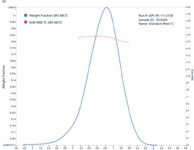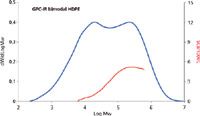High Temperature Gel Permeation Chromatograph (GPC/SEC) with Integrated IR5 MCT Detector for Polyolefin Analysis: A Breakthrough in Sensitivity and Automation
Polymer Char Application Note
Introduction
Gel permeation chromatography (GPC), also referred to as size exclusion chromatography (SEC), when applied to polyolefins analysis (Polyethylene, PE and Polypropylene, PP) has been considered a demanding task due to the high temperature required for operation and the use of hazardous chlorinated solvents for resin dissolution.
In the last twenty years the sample preparation process, of major importance in the GPC/SEC analysis of polyolefins, has not advanced significantly; vials are being filled with solvent manually and in most cases external filtration after dissolution is carried out with subsequent manual vial transfer before injection. Sample degradation, especially in the case of polypropylene, has not been fully eliminated and samples still remain at a high temperature longer than required for proper dissolution.
It has been common practice to place the GPC/SEC columns, injector valves and detectors in the same oven compartment and when loop size or filter needs to be changed or the detector maintained the whole system needs to be cooled down to prevent column damage; thus, requiring slow cooling and heating rates and a long stabilization time before analysis can be performed.
Little effort has been applied to investigate chemical composition - molar mass interdependence in the case of polyolefins, and when it was established it demanded off-line FTIR systems or external flow through cells with liquid nitrogen cooled detectors.
With these considerations in mind, Polymer Char initiated the design of a totally new GPC/SEC system based on a well-known infrared detector (IR4) which provides good stability and sensitivity for the analysis of polyolefins; infrared detection results in equivalent Molar Mass Distributions (MMD) curves to those obtained by DRI and without the presence of negative or spurious peaks after polymer elution.
Today, the use of the IR4 detector in GPC/SEC analysis is common in many laboratories, meaning a significant breakthrough in detection technology. For the first time simultaneous concentration and composition signals were obtained on a single instrument; the composition signal allows the measurement of branches in PE copolymers, ethylene content in EP copolymers and vinyl acetate in EVA resins, all along the molar mass distribution. This new dimension in GPC analysis (Chemical Composition) comes at a time when new commercial copolymer resins demand such a composition–molar mass interdependence analysis.
Instrument Description: New GPC-IR
In this application note we describe the full integration of the new infrared detector IR5 MCT, which has outstanding sensitivity and stability, into the GPC-IR instrument redesigned in 2012.
Besides the IR5 MCT detector and the most advanced sample preparation system, the new GPC-IR incorporates other technological developments, (see Figure 1), to fulfill Polymer Char's design philosophy, based on the principles of the most reliable hardware, full automation, user friendly operation, easy maintenance and proper diagnostic tools:
• Three independent thermostated compartments with adjacent walls for reduced length of connecting tubing are included within the main body of the GPC-IR which also holds all the instrument electronics:
• independent column oven,
• injector and filter compartment,
• detectors compartment.
• Separate high temperature autosampler module, in which sample preparation takes place.
• Solvent management system incorporating Agilent HPLC pump and degasser, syringe dispenser and a software-controlled solvent recycling system.
• Differential viscometer and optional DAWN® HELEOS™ II Multiple Angle Light Scattering (MALS) detector from Wyatt Technology® , complementing the IR5 MCT detection, and optional IR4.
• Advanced and comprehensive processing software GPC One which integrates all detectors' signals in a single package.
• Virtual Instrumentation Control software with advanced diagnostics tools and prepared for remote control access.

Figure 1: Schematic diagram of Polymer Char high temperature GPC-IR system.
Sample Preparation
The GPC-IR system has been designed with a fully-automated sample preparation approach, minimizing the user interaction and eliminating manual solvent handling, while at the same time taking care to prevent sample degradation. The analyst needs only to weigh the samples into separate vials and place them in the autosampler tray where they will stay at room temperature waiting for the dissolution step (Figure 2).

Figure 2: GPC-IR sample preparation process.
The autosampler can handle 70 vials of 10 mL and the new design can accommodate 40 vials of either 10 or 20 mL for a better sample prepartion. In both cases vial inserts of 3 mL can be used when having only a few milligrams of sample.
The control software takes care of the overall solvent-handling process and dissolution time coordination with steps as shown in point 4 of Figure 2. Samples solution stay at a high temperature for just the required time for dissolution.
Solvent preheating before vial filling, a heated carousel with forced airflow and vial shaking results in a very efficient but gentle dissolution process.
Sample degradation in polypropylene and in very high molecular weight (MW) polyolefins is minimized. This was made possible by the elimination of oxygen from the vial and solvent, through the nitrogen purge and installed degasser, the precise control of time and temperature in the dissolution step and the avoidance of stirring bars which may result in shear degradation.
A significant effort was devoted to developing a fully automated operational in-line filter media and filtration process which would be reliable and last for months.
Filtration is performed during the filling of the injection loop; therefore, only a small part of the solution needs to be filtered. Once the injection is performed, the filter is back-flushed with a significant solvent volume from the syringe to have the filter clean and ready for the next sample filtration.
New Integrated Infrared Detector IR5 MCT
The most important aspect of infrared detection of polyolefins is the good sensitivity, baseline stability and fast stabilization periods as has been demonstrated by the extensive incorporation of the IR4 detector in existing GPC systems. Besides sensitivity and stability of the concentration signal, infrared detection provides a continuous and simultaneous measurement of chemical composition along the MMD.
New developments in infrared technology have allowed us to integrate a highly sensitive Mercury Cadmiun Telluride (MCT) detector (thermoelectrically cooled) into the GPC-IR, thereby eliminating the need for heated transfer lines. The results obtained show an outstanding improvement in signal-to-noise ratio over the standard IR4 of around ten times in both concentration and composition signals. Besides sensitivity improvement, the now integrated IR5 MCT is not affected by variations in laboratory temperature due to the carefully controlled detector environment, resulting in superb long-term baseline stability.

Figure 3: Recording baseline of four injections (two per vial) using three Agilent PLgel Olexis GPC/SEC columns and 2 mg/mL, 200 µL loop. Red signal: Concentration. Blue signal: Composition (CH3/1000C emphasis).
The analysis of two metallocene PE samples, each one by duplicate from the same vial, is shown in Figure 3. An excellent sensitivity and baseline stability can be observed in concentration as well as composition signals for an injection of 200 microlitres of a solution of 2 mg/mL in a 3 Agilent PLgel Olexis column. The good definition of baseline is the basis for the precise calculation of MW moments.

Figure 4a: Recording baseline of one of the PE analysis of Figure 3. Red signal: Concentration. Blue signal: Composition (CH3/1000C emphasis).
In Figure 4a an expanded view of one of the curves is presented without any smoothing to show the good sensitivity and stability achieved. The calculated MMD is shown in Figure 4b with compositionmolar mass interdependance.
The high sensitivity of the IR5 MCT allows us to reduce the injected amount of sample into the column preventing viscous fingering effects and columns damage when analysing high MW polyolefins. The repeated analysis of one of the samples by lowering the concentration down to 0.2mg/mL is presented in Figure 5 maintaining a good s/n ratio and baseline stability.

Figure 4b: Calculated MMW of sample of Figure 4a showing the composition â molar mass interdependence.
A significant advantage of using the integrated IR5 MCT detector is in the composition analysis along the molar mass of PE with a very low number of branches like in the case of HDPE pipe resins grades, which previously required the use of FTIR with detection at liquid nitrogen temperatures. The analysis of a pipe resin with a low number of branches is shown in Figure 6 with a limit of detection of less than 1 CH3/1000C.

Figure 5: Recording baseline of duplicate PE analysis at different concentrations and with 200 µL loop.
Conclusions
The integration of the new IR5 MCT detector into the GPC-IR results in an outstanding sensitivity in both concentration and composition signals; this is an order of magnitude better than the existing IR4 detector. The new design of the IR5 MCT makes it also very resilient towards external temperature changes, while an order of magnitude improvement in baseline stability has been achieved as well; never before has the stability and sensitivity of GPC analysis of polyolefins reached such a mark.

Figure 6: Analysis of a bimodal HDPE pipe resin grade with low number of branches. GPCâIR run at standard conditions 200 µL injection of 2 mg/mL with 3 Agilent PLgel Olexis columns.
A good baseline definition is the basis for precise MMD analysis and calculation of MW moments. Reducing the amount of polymer injected when dealing with high MW materials reduces plugging problems, extends column life and eliminates or minimizes viscous fingering spurious effects.
Full automation of the sample preparation with special care to avoid sample degradation and the incorporation of automated solvent recycling are presented in the new GPC-IR design.
Polymer Characterization S.A.
Gustave Eiffel 8, Paterna, Valencia E-46980, Spain
tel. +34 96 131 81 20 fax +34 96 13181 22
E-mail: info@polymerchar.com Website: www.polymerchar.com


.png&w=3840&q=75)

.png&w=3840&q=75)



.png&w=3840&q=75)



.png&w=3840&q=75)













